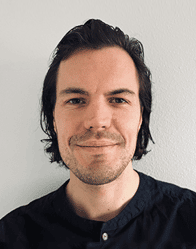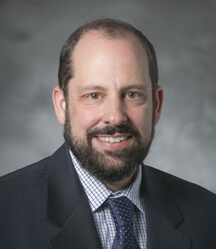Season 1 – Episode 5 – Technology Transfer and Commercialization
This episode discusses common technology transfer issues that university faculty and staff should be mindful of when developing technology that may be commercialized, ways to navigate those issues, current events they should be paying attention to, and additional resources they can utilize to navigate the commercialization of technology.
Episode Transcript
Click to expand/collapse
Daniel Smith: Welcome to On Tech Ethics with CITI Program. Today’s guest is Eric Wagner. Eric is the Director of Legal Affairs for Duke University’s Office of Translation and Commercialization. We are going to discuss some common technology transfer issues that university faculty and staff should be mindful of when developing technology that may be commercialized. We will also go over some ways faculty and staff can navigate these challenges, current events they should be paying attention to, and additional resources they can utilize to navigate the commercialization of technology.
Before we get started, I want to quickly note that this podcast is for educational purposes only. It is not designed to provide legal advice or legal guidance. You should consult with your organization’s attorneys if you have questions or concerns about the relevant laws and regulations discussed in this podcast. In addition, the views expressed in this podcast are solely those of our guests. Okay, so let’s get into it. Welcome to the podcast, Eric.
Eric Wagner: Thank you for having me.
Daniel Smith: Absolutely. So just to get started, tell us a bit about yourself and what you focus on at Duke University,
Eric Wagner: Sure. So my name Eric Wagner. I’m director of Legal Affairs with Duke’s office for Translation and Commercialization. We recently had a name change from Licensing Adventures. My background is in biochemistry and immunology. I’ve been practicing intellectual property law now for a little over 20 years. I’ve been with Duke University since May of 2009, and in my role here in OTC, we manage the intellectual property that comes out of Duke University and manage that for commercialization, licensing, startup companies, things like that.
My primary role is to help secure intellectual property, manage outside council, and make sure that we get all the patents, copyrights, and things protected for commercialization, but also then working with our licensing staff on license negotiations and our general counsel staff for infringement and other IP related legal matters that come through the university.
Daniel Smith: Thank you, Eric. Now, before we talk more about the different types of intellectual property, can you quickly touch on what the goal of technology transfer is in the university setting?
Eric Wagner: Sure. So the goal of technology transfer really is to get the new research and inventions that are developed at the university out into the marketplace where they can do good for humankind. So one of the goals that came out of the whole Bayh-Dole Act was to try to help incentivize universities, particularly those using federal research funding to try to help get those inventions out into the marketplace.
The goal of our office is really to help identify those inventions, adequately secure them so that we can protect intellectual property around those, but then to help market and work with outside companies, or like I said, with inventors that are coming out of Duke are interested in doing a startup, getting these into the commercial setting so that they can be further developed and then out into the marketplace.
Daniel Smith: So you mentioned intellectual property. What are the common types of intellectual property?
Eric Wagner: So there’s four basic types of intellectual property. You have trade secrets, you have trademarks, you have copyrights, and you have patents. The most common types of intellectual property that come through our office are copyrights and patents. Patents which cover new and useful inventions, compositions and matters, methods of doing something, methods of using something, methods of making something. Those are the most common types that come through.
We have been getting a number of copyright based inventions that come through, and these are around more software related things, particularly new ways of doing something, new ways of analyzing data, new ways of using machine learning to help train a system in order to give better results or help guide medical staff on making a diagnosis, things like that.
The other two types of intellectual property, trade secrets and trademarks, are really more on the commercial side our office doesn’t really deal with those quite as much. Trade secrets, those kind of run counter to what the goal of the university mission is. Sorry. Our goal is to get information out into the public for everyone to use. Trade secrets are trying to keep something as secret within a company. So we usually leave the trade secrets to our licensees and/or startups who use our technology. Similar with trademarks. Trademarks are really used to identify a product or good in the service in the marketplace. That’s, again, something that’s more driven by our licensees or our startup companies. So we generally defer the trademark protection to them.
Daniel Smith: That definitely makes sense. So with that in mind, how are copyrights and patents protected?
Eric Wagner: Right. So copyrights, you can get an implicit copyright once you satisfy the three requirements. So if you have originality, it has minimal creativity, and you fixate it into some kind of medium, like type it into your computer or save it onto a hard drive or something along those lines, you have an implicit copyright. So with that, you can say you have a copyright. You can take the extra step and record that copyright with the United States Copyright Office, and that’s a pretty simple process to do, pay a fee and submit your copyright.
The patents, on the other hand, are a little bit more involved and more expensive. Those you have to go through the US Patent and Trademark Office. And so that becomes a little bit more of a hard decision for us. As most universities, we have a fixed patent budget, so we have to make decisions on when’s the right time to secure a patent. Is it an invention that we think that we can commercialize and has potential to make it in marketplace? Does it satisfy all of the requirements for a patent? Is it patentable subject matter? Is it novel? Is it not obvious? So those are decisions that our office works with our faculty and staff on when inventions are submitted to kind of help figure out what’s the best way to move forward.
Daniel Smith: I think that the patent process could be a whole podcast series in and of itself.
Eric Wagner: Yes, it can.
Daniel Smith: But what are some of the common issues that faculty and staff should be mindful of when it comes to the patent or copyright process?
Eric Wagner: So for the patent process, we’ll start with the patent process. I would say some of the most common issues that pop up are disclosures. So you always need to stay in front of the inventor’s academic responsibilities, and that is to publish and to go speak at conferences. And now that COVID’s over, all of the conferences are starting back up again. And so the imminent disclosures are becoming a lot more common.
So it’s important that we stay in front of that as a public disclosure before we file a patent application and can become a patent bar. So working with your tech transfer office and ensuring that you keep them up to date on what’s happening and what your speaking and publishing schedule is looking like is going to be really important.
From a software standpoint, one of the big issues that comes into play is whether or not open source software code is being used. Oftentimes faculty and staff who are creating new software use a lot of open source and there’s background rules and regulations on licensing, protectability, and copywriting that go along with that. So depending on what type of open source you’re using, it could really have an impact on whether or not you’re going to be able to commercialize that.
Something else that needs to be kept in mind are really for any type of third party involvement that might play a role in the intellectual property. So that can come in the form of co-ownership. So if you’re co-inventing with other institutions or companies, that can create a joint ownership issue when you file your intellectual property. Any kind of grant support or other type of funding, whether it comes through a foundation, from the federal government, or through the sponsored research agreement with another company, there’s oftentimes intellectual property rules that go along with that as well. So that could also have an impact on how you can protect intellectual property, where you can do it, and whether or not you’re going to be barred from doing certain licensing activities or commercial activities.
So it’s important to have all of that information upfront as you’re coming up with your IP strategy so you can take all that into account and come up with the best path to move forward.
Daniel Smith: So just for quick clarification, you mentioned tech transfer offices. Can you provide a quick overview of the role of a university tech transfer office?
Eric Wagner: Yeah, so most universities who have a research program have some type of tech transfer office, and this is the office that’s going to be responsible for really being the interface between the university and the marketplace. So that office is going to be the one that’s going to be responsible for helping you secure the intellectual property that you need and preparing and negotiating the license agreements that are going to be necessary to help commercialize that intellectual property.
Depending on how big the university is, how big the research aspect is, there could be other offices that work in conjunction with your tech transfer office, such as a grants office or a outside contracts office, who might be the ones responsible for establishing like sponsored research agreements with a company, for example, or working with the NIH or other federal agency on maintaining the grant and keeping tabs on intellectual property that’s associated with that federal funding that comes out of that grant.
Daniel Smith: Thanks, Eric. So definitely tech transfer offices are there to help faculty and staff navigate the IP challenges that come up?
Eric Wagner: Definitely.
Daniel Smith: Do you have any other recommendations for how folks can navigate the challenges that you previously mentioned?
Eric Wagner: I think the most important thing is to stay in touch with your tech transfer office early and often. The more familiar the technology transfer office staff is with your technology, the better they’re going to be able to help guide you through next steps, how best to protect your intellectual property. And more importantly, they’ll be involved so that out for your disclosures and your publications and your conferences, they’re going to be aware of all that and can work with you so you’re not working under really tight deadlines to make sure we have everything protected.
And they’re also very important to kind of help you navigate any potential other issues that may come up. As we talked about, if you have a grant or if you have some other third party involvement with the university, their tech transfer office is going to be the one that’s going to be able to help you navigate any type of IP terms or other restrictions that may go along with something that you’re going to do or are doing within the university.
Daniel Smith: And aside from tech transfer offices, are there any other additional resources out there?
Eric Wagner: Sure. So I know AUTM, the association for the university tech transfer management, technology management, they have a number of resources that can be very helpful, particularly on the actual nuts and bolts of the technology transfer office function and working with them. Another good resource would be the American Intellectual Property Law Association, particularly for keeping up on tabs with different IP matters that are coming up. And there’s often things happening within the court systems that are interesting and may have an impact on doing patent strategy.
Daniel Smith: You mentioned interesting cases working their way through the courts. Are there any current cases that people should be paying attention to?
Eric Wagner: Yeah, there’s two things kind of making their way through the court system and the federal government right now that I’m keeping a close eye on. The one is around the section 101 issue, and that’s the patentability, patentable subject matter, patentability subject matter section of the patent law. About 10 years ago, there were a couple cases that came through that really impacted the ability to protect, particularly on the biological side, what’s called naturally occurring elements, and also on the software diagnostic side for something called abstract ideas.
These have kind of thrown a monkey wrench in some of IP strategy around software and diagnostic method patents, and Congress has been working over the last several years of maybe trying to come up with some kind of legislation to help get some clarity around the 101 issue. And it comes in fits and starts, but it looks like there might be another push to try to get something through. So keeping on top of that I think is going to be useful.
Something else that’s just happened in the world of antibodies, there was a case a few years ago from Amgen that was held that limited the scope of antibody claims in a patent. That has been taken up by the Supreme Court and this year is going to argued before the Supreme Court this year, and that’s going to be one that’s going to be really interesting to keep a close eye on to see how the Supreme Court rules on that and whether or not that’s going to have impact on the world of antibodies and patenting moving forward. So we’re keeping a close eye on that one.
Daniel Smith: Definitely two important cases for folks to keep eye on. And I’ll be sure to include some links to additional resources in the show notes where listeners can learn more. So on that note, Eric, thank you again for coming on the podcast and sharing your insight on how faculty and staff can better navigate the challenges that come with commercializing their work.
Be sure to follow, like, and subscribe to On Tech Ethics with CITI Program for more conversations on all things tech ethics. I also invite our listeners to review CITI Program’s technology transfer course, which provides a comprehensive overview of university technology transfer and commercialization processes, including partnering with a technology transfer office, protecting intellectual property, establishing appropriate agreements, and licensing to or starting a new company. All of our content offerings are available to you anytime through organizational and individual subscriptions.
How to Listen and Subscribe to the Podcast
You can find On Tech Ethics with CITI Program available from several of the most popular podcast services. Subscribe on your favorite platform to receive updates when episodes are newly released. You can also subscribe to this podcast, by pasting “https://feeds.buzzsprout.com/2120643.rss” into your your podcast apps.
Recent Episodes
- Season 1 – Episode 4: Ethical and Policy Issues in Chimeric Research
- Season 1 – Episode 3: The Impact of ChatGPT on Academic Integrity
- Season 1 – Episode 2: Artificial Intelligence in Human Subjects Research
- Season 1 – Episode 1: Introduction to On Tech Ethics
Meet the Guest
Eric Wagner, PhD, JD – Duke University
Eric Wagner serves as Director of Legal Affairs in Duke University’s Office of Licensing and Ventures. As a registered patent attorney, his responsibilities include the preparing and prosecuting of patent applications, assisting OLV staff regarding patent and licensing matters, as well as the management of intellectual assets owned by Duke University.
Meet the Host

Daniel Smith, Associate Director of Content and Education and Host of On Tech Ethics Podcast – CITI Program
As Associate Director of Content and Education at CITI Program, Daniel focuses on developing educational content in areas such as the responsible use of technologies, humane care and use of animals, and environmental health and safety. He received a BA in journalism and technical communication from Colorado State University.








